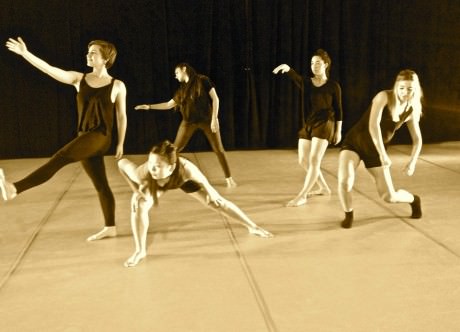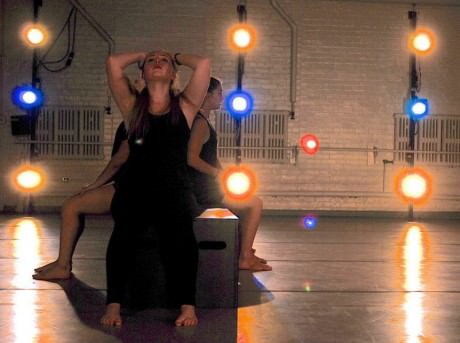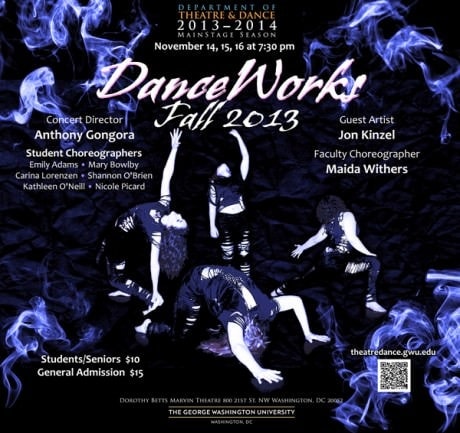The structure of the George Washington University Department of Theatre and Dance’s DanceWorks Fall 2013 concert is absolutely wonderful. The audience is welcomed into the concert with a faculty piece, choreographed by the esteemed Maida Withers, followed by six student works, and ending with a guest artist piece, by New York City choreographer/dancer Jon Kinzel. Seeing the various stages of art, be it by someone who has choreographed over one hundred pieces, someone who has choreographed over thirty pieces, or people embarking on their first or second choreographic work, allows an audience member to take away the benefits of experience and inexperience all at once. The excitement of that first or second piece of choreography gives the performers dancing for those choreographers the pride and joy of having been an integral part of the creation of the work. When working with a more established artist, either on a re-staged work or a new piece, the process is different, and is more about picking up the choreographer’s established style and nuances, and less about the ups and downs involved in being in someone’s first piece. The costumes for the piece, from the various items the duet of dancers changed out of at the top of the piece to the black, white, and red ensembles the dancers wore for the remainder of the piece, were designed by Reema Al-Bawardy.
The first piece in the concert, Maida Withers Yesterday’s Garlands and Yesterday’s Kisses featured four dancers (Ian Ceccarelli, Nicole Colameta, Cat McCormack, Becca Melvin, and Ben Sanders), and was set to live music by John Driscoll, who performed with the Maida Withers Dance Construction Company when the piece premiered in 1975. The movement in the piece ran the gamut of dance from pedestrian and familiar movement, to presentational and unfamiliar movement. The piece began with a striking pair of dancers on separate stools, taking off layers of clothing. The mix of internal and external focus, as well as stillness in the body, was captivating. As the piece progressed, the sound score involved a mix of familiar sounds and almost cartoon-ish sounds. The movement incorporated multiple gestures, and as the piece unfolded these gestures came back in waves by various dancers. The use of text was wonderful, as the dancers and a vocalist (Maxwell Deem) recited the tongue twister “Peter Piper picked a pack of pickled peppers.” The nonsense in this familiar phrase echoed the piece’s homage to the Dada aesthetic. This piece was a marvelous start to the show, as it shook up the audience and lightened the mood in the theatre.
Emily Adams’ Persistence Down Memory Brick Lane (featuring Melyssa Granat, Juman Kekhia, Rachel Kleiman, Sarah Miller, Sophie Moyer, and Amy Thompson) was a beautiful look at the cyclical nature of life, set to “Experience” by Ludovico Einaudi. Dressed in simple black dresses designed by Sara Abdulghani, the dancers represented growth, and how one can enter a place in one state of being and leave that place a more mature person, having done all of the living they did in that place. The people you interact with can come and go, though some stay and those bonds form stronger and stand the test of time, and this was represented in the entering and exiting the dancers did throughout the piece. Adams’s eye for the proximity of the dancers to one another and the various pairings and groupings of dancers is keen.
Mary Bowlby’s i come alone here (featuring Emily Gentile, Marissa Kardon-Weber, Lauren Lamb, Laura Rouse, and Gwen Walker) is, in essence, a study of a bench. Set to “Promise” by Ben Howard, with dancers in various separates in a burnt orange hue designed by Reema Al-Bawardy, Bowlby took two benches and examined the people that inhabit and come in contact with said benches. I felt like I was looking at a collection of time-lapse photos from these two benches, each in different physical places. The beautiful thing about this concept is the masterful choreographic touch Bowlby used in expressing the various physical landscapes of the dancers at the same bench. Some people may be frustrated; some may be melancholic, while some may be at peace and waiting for what’s next. My favorite moment in the piece was the one dynamic shift I felt, in which the dancers sped up and slowed down at various rates, allowing me to experience this gesture-specific movement at different paces at the same time. The idea that one person’s life may slow down while the people around them are going non-stop, and vice versa, was communicated for a fleeting moment in this piece of choreography, and I would have liked to see that theme developed fully.

Nicole Picard’s Footprints (featuring Leah Bartolacci, Jen Canace, Alessandra Cigna, Janie McDermott, and Alexandra Meyer) is a wonderful expression of dance for dance’s sake, set to “Skokkseyri” by Jonsi and “Skeletons” by the Yeah Yeah Yeahs. What rings true in Picard’s full-bodied choreography and her dancers’ attack and exuberance in performance is the joy of performing for an audience. In various white dresses with exquisite and unique backs designed by Sigridur Johannesdottir, Picard explores memories, and what happens as we reflect. Hindsight does interesting things to our memories, and allows us to look at nuances we didn’t fixate on as we were living in the moment. In the details of the choreography, and the use of proximity of dancers to each other, this theme was rather prevalent. Repetition in the movement was helpful, as I felt I was experiencing the movement in the moment the first time, and when it came back a second time I felt the reflection on the memory of that movement and the focus of the second moment was different than that of the first.

The first piece in Act Two, Shift by Shannon O’Brien (featuring Phoebe Bui, Kendall Coniaris, Melanie Eccles, Caroline Schau, Angela Schopke, and Rachel Zappala), is absolutely breathtaking and set to the lively track “Bilar” by Ratatat. Clad in green and black rompers designed by Debbie Kennedy, O’Brien has created a quirky and stunning exploration of geometric and specific floor work that translates into very efficient and machine-like standing movement through the space. With a striking installation of shiny, metallic objects hanging from above the dancers heads, the piece is full of moments where one of the objects hits the light just right and there is a glorious shine in the high space above the dancers. I felt like I was watching either creatures awakening from the depths of the earth or a scientific cycle one learns about in a biology class. The dynamic unpredictability in this work was a lovely way to begin the second act and excite me for the remainder of the concert.

Ruminate by Kathleen O’Neill (featuring Gabrielle Garruppo, Melyssa Granat, Becca Melvin, and Sophie Moyer), looks at friendship and difference between living as an individual versus living as an integral part of a well-functioning group of friends. Set to “San Solomon (reprise)” by Balmorhea, O’Neill’s stunning dancers, in blue tops of varying sleeve lengths and blue velvet skirts designed by Elizabeth Taufield, enter crawling on their backs as one dancer stands and surveys the performance space. I felt as if this dancer was recalling the memories of this group of friends. There is a lovely sense of nostalgia in the movement and music, as we explore how one lives their life in this close-knit bond. As the bond becomes it’s closest, the dancers move as one unit in perfect unison for a few fleeting moments, well crafted by O’Neill. The disintegration of this bond and how each dancer learns to exist in this world as a singular entity is quite striking and unexpected.
Carina Lorenzen’s Unrelenting Resilience (featuring Juman Kekhia, Sophie Moyer, Jennifer Canace, Kendall Coniaris) is a rousing quartet set to “Gravity” by Steven Price, edited by Meghan Bernstein. This ultimately athletic and adrenaline-infused expression of movement begins with subtle, striking gestures on a long bench, extending from offstage to center stage, and pretty far upstage as well. The piece ebbs and flows, dancers in cobalt blue dresses designed by Polly Gregory, with multiple moments of climax in the movement, before the music reaches a place where that is expected. I commend the dancers on their 110% commitment to this athletic, at times acrobatic, and full-bodied movement. The leaps off of the bench and into each other’s arms are stunning, and performed with little to no preparation, allowing the audience to be surprised. There is a seamless nature to these movements that comes from Lorenzen’s adept coaching. What I will say about the piece is I didn’t feel the need for the extended bench at all times, and some of the interactions with the bench felt a little expected and didn’t always feel original. The final cue of the piece, however, was absolutely stunning, as one dancer runs and flings herself off of the elongated bench, and the lights cut out before the dancer landed in the other dancers’ arms. A very strong start and an equally as strong finish made me want a little bit more out of what happened between these two points.
Jon Kinzel’s Afternoon Amnesia, set to a score by Joseph Haydn (featuring Rayna Bagchi, Andree Beals, Shaffer Bond, Kendall Coniaris, Juman Kekhia, Cat McCormack, Christina Montesi, and Ben Sanders) is a delightful piece of choreography, with black costumes with a pop of color designed by Debbie Kennedy. This study of efficient movement and specific, and repetitive, gesture was wonderful to watch. The dynamics and focus of the dancers was wonderfully coached, as there was an overall ease to the experience of watching this piece. The partnering work felt like a puzzle, with each dancer representing a piece, and I was able to see the mechanics of these moments with stunning clarity. The pathways through which the dancers travelled and the pairings and groupings of dancers was also interesting and kept me guessing.
The lighting design of the concert, by Felipe Oyarzun, was a fabulous connective thread. Oyarzun captured the essence of each choreographer’s voice, and beautifully translated that into a sharp, specific and emotional design of the concert.
On the whole, this concert was artistically invigorating and inspiring, as well as masterfully performed and spectacularly choreographed. Supporting this concert of choreographers at various stages in their artistic process is integral in the survival of the field of dance. Dance companies cannot proliferate without patrons of the arts, and what better way to help further the field of dance than attend a concert at The George Washington University?
Running Time: 90 minutes, with a 15-minute intermission.
The George Washington University Department of Theatre and Dance’s DanceWorks Fall 2013 plays tonight, Friday, November 15, 2013 and Saturday, November 16th at 7:30 pm, at The George Washington University’s Dorothy Betts Marvin Theatre – 800 21st Street, NW in Washington, DC. For tickets, order them online, purchase them at the box office, or call (202) 994-0995.





